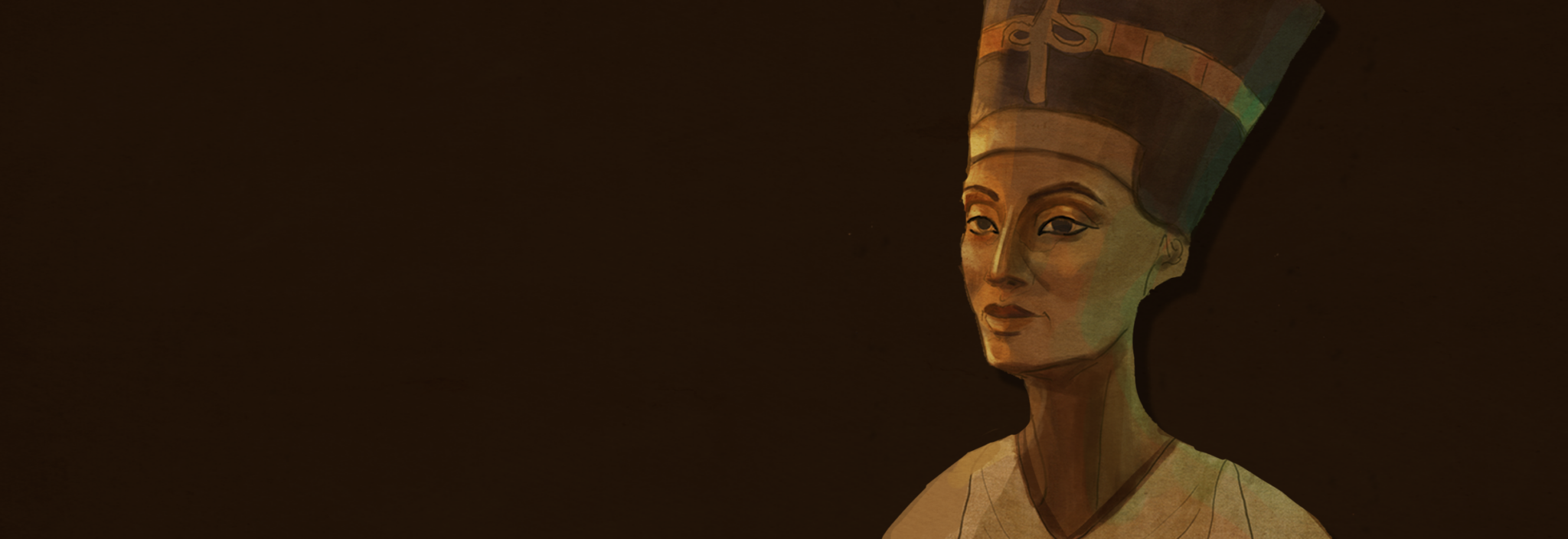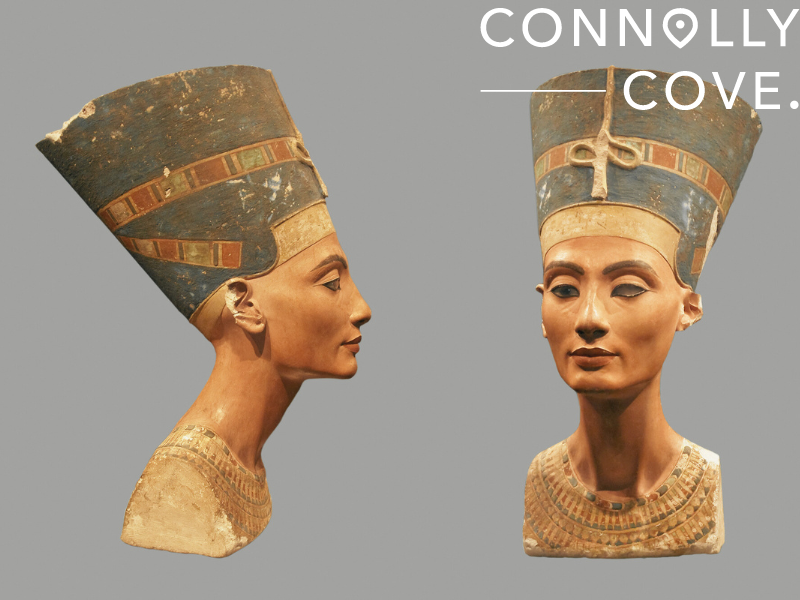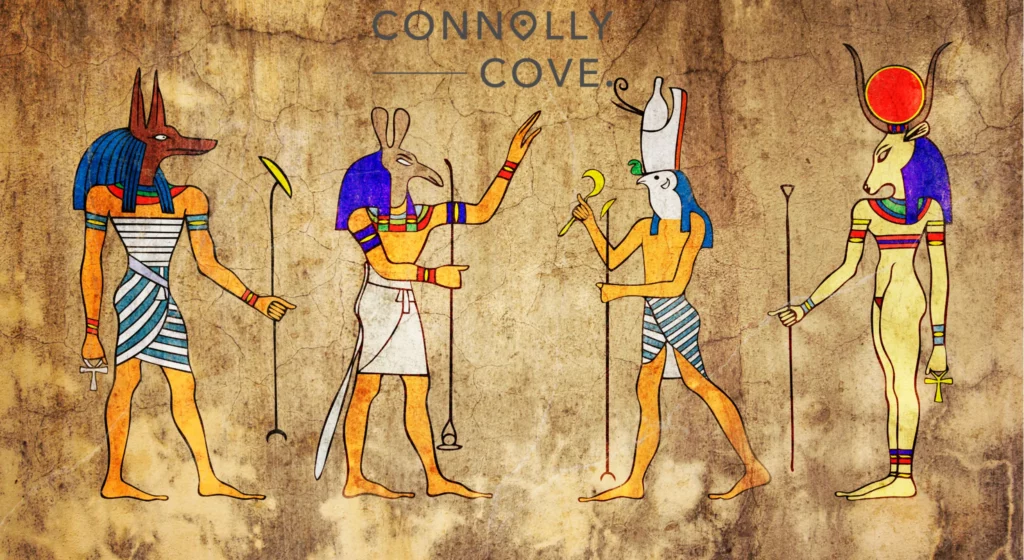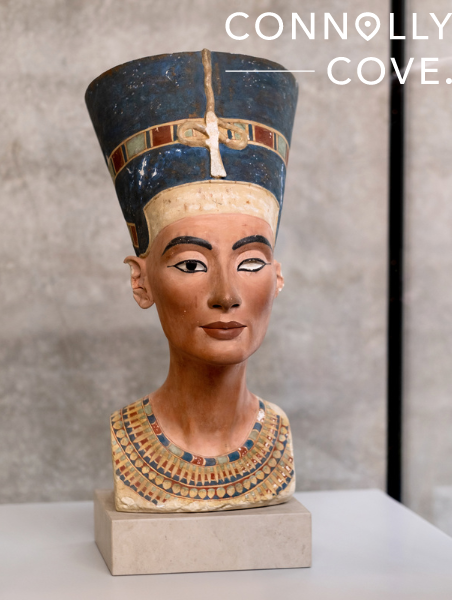The Mysterious Life of the Mighty Queen Nefertiti

Updated On: February 19, 2024 by Noha Basiouny
On Friday, 6 December 1912, and after what seemed like a long search, German Egyptologist Ludwig Borchardt together with a team of other archaeologists discovered the legendary bust of Nefertiti, the royal wife of the ancient Egyptian Pharaoh Amenhotep IV or Akhenaten as he later decided to call himself.
Currently displayed at the Neues Museum in Berlin, the vividly-coloured, life-size bust is a remarkable work of art that captures Nefertiti’s elegance and her status as an influential Queen. It has placed her as an international beauty icon, making her face one of the most recognised ones in the entire world and becoming itself one of the most copied and replicated artworks there are.
The enchanting bust shows realistic facial features of Nefertiti, with thick, arched eyebrows, beautiful eyes having the shape of almonds, high cheekbones, a straight nose, delicate lips and a long, slender neck. There is also the mysterious yet mesmerising smile on the Queen’s face that challenges anyone who has ever set an eye on the bust to interpret it.
Nefertiti is as mighty as she is mysterious. She lived during one of the most controversial periods in ancient Egypt. In fact, she had a great hand in making a radical change in ancient Egyptian society, and this is precisely the story we are telling you today. So bring a big cup of coffee because we are going over three millennia back in time.
Queen Nefertiti

Nefertiti was the Great Royal Wife of Pharaoh Amenhotep IV, or Akhenaten. He was the 10th Pharaoh of the 18th Dynasty, the first of three dynasties that made the New Kingdom of Egypt, the most glorious golden age of the entire ancient Egyptian civilisation. Akhenaten ruled for 17 years, from 1353 to 1336 BC, a period during which he and his beloved wife, Nefertiti, made substantial radical changes in the religious system in Egypt.
Name
Besides the lovely sound of it, the name Nefertiti is actually two parts. There is Nefer which means beautiful in the ancient Egyptian language, and iti, which means woman. So, all in all, Nefertiti means “a beautiful woman has come”, a claim confirmed by the stunning bust of the mighty Queen.
In addition to that, beautiful Nefertiti had many other names that describe her beauty and how much she was loved. For instance, she was often called Great of Praises, Lady of the Two Lands, usually referring to Upper and Lower Egypt, Sweet of Love, Lady of Grace, and Lady of all Women—sure thing, she was the Queen, after all.
Origin
Nefertiti was born in 1370 BC in Thebes, or modern-day Luxor, during the reign of Pharaoh Amenhotep III, which stretched from 1390 to 1353 BC. Amenhotep III was the father of who would later become Nefertiti’s husband and the next-in-line Pharaoh Amenhotep IV, or Akhenaten.
Not much is known for sure about Nefertti’s childhood and her life before she married Akhenaten. However, scholars could come up with some speculations based on scenes and inscriptions found on the tombs of some noblemen. So here is what they theorised about Nefertiti’s origin.
Nefertiti’s parents were Ay and Tey. Ay was a nobleman and the advisor of multiple pharaohs, one of whom was the young King Tutankhamun of the 18th Dynasty. Ay is thought to be the son of Yuya and Thuya, a powerful noble couple who held high positions in the government and were close to the royal family. Ay had a brother called Anen and a sister, Tiye, who later married Amenhotep III, Akhenaten’s father.
Based on this theory, Ay was then Akhenaten’s uncle, which then made Nefertiti and Akhenaten cousins.
Tey was Ay’s wife and the one thought to be Nefertiti’s mother. She held the title “The Nurse of the Great Royal Wife” and was in charge of taking care of Nefertiti’s children. Later on, Ay ascended to the throne in 1323 BC, around 13 years and seven years after the death of Akhenaten and Nefertiti, respectively. Ay served as the 14th or the second to last Pharaoh of the 18th Dynasty, and therefore, Tey became the Queen.
Based on these speculations as well, Nefertiti is believed to have had a younger sister called Mutbenret, who was a noblewoman and a highly considered personality in society back then.
Another theory claims that Nefertiti was Ay’s daughter from his first wife, who died while Nefertiti was still young. After that, Ay married Tey, who then became Nefertiti’s stepmother.
Marriage
Nefertiti married Akhenaten at a pretty young age, for she was only 17 when Akhenaten came to power in 1353 BC after the death of his father, Amenhotep III.
Together, Nefertiti and Akhenaten had six daughters named Meritaten, Meketaten, Ankhesenpaaten, Neferneferuaten Tasherit, and Setepenre, from oldest to youngest.
Akhenaten also had another son, Tutankhamun, who was born in 1341 BC. Yet, Nefertiti was not his mother. In fact, Akhenaten had at least four other wives than Nefertiti, so one of them could potentially be the young Pharaoh’s mother, yet this has not yet been confirmed.
Interestingly, Akhenaten’s third daughter, Ankhesenpaaten, would later marry Tutankhamun and become the Queen of Egypt when the latter ascended to the throne a few years after Akhenaten’s death as we will see in a bit.
Nefertiti is often depicted with her husband and their daughters on the temple walls and royal tombs, always accompanying her husband and sometimes even alone with her daughters.
It is even reported that Nefertiti was depicted more than Akhetaten, the Pharaoh himself. This refers to her significance as a Queen and her power that allowed her to rule side-by-side with Akhenaten and support him in the new religious approach he took.
Akhenaten and Nefertiti made a dramatic transformation in the religious system that had been prevalent in society ever since the dawn of Egyptian civilisation. It was also this very transformation that almost got the royal couple completely erased from historic records later on.
The Ancient Egyptian Pantheon

To understand the significance of Akhenaten’s religious revolution and the severe disruption he made in Egypt at the time of his reign, we need to take a look at the predominant religious system back then.
The ancient Egyptian religion was based on polytheism, that is the belief in many deities, each of whom was responsible for one or more aspects of life and all together controlling the forces of nature. Ancient Egyptians believed in more than 1,400 deities, worshipped them, built temples and shrines for them, performed rituals and offered sacrifices to please them.
Some of the most famous and powerful deities include Isis, the goddess of healing, magic and wisdom, Osiris who was the god of fertility, the dead and the afterlife and their famous son Horus, depicted as a falcon-headed man, was the god of sky and war who later married Hathor who was the goddess of love, pleasure and beauty.
Ra was the Sun god, the king of all other deities and the creator of the Universe. During the New Kingdom of Egypt, Ra merged with Amun, who was the god of air and received increasing significance over the years, to become Amun-Ra. Amun-Ra then became the chief deity in ancient Egypt and the one all creatures, great and small, abided with.
Every god and goddess was based in and had cults in different cities all across Egypt, where ancient Egyptians built temples to worship them. The cult of Amun-Ra was based in Thebes, the state capital during the New Kingdom and the magnificent Karnak Temple Complex was built over millennia and a half to worship and celebrate Amun-Ra.
The priests of Amun were in charge of the temples, the official religious establishments in the country. They controlled everything related to them. This included the fund they received from the government, the revenue of the land owned by the temples, the donations made by the worshippers, etc.
The authority of the priests grew over the centuries until it reached the peak during the New Kingdom. With power and money, the priests were able even to have a political influence that could potentially change the course of events in the country.
Well, this is precisely what Akhenaten and Nefertiti threw aside.
Atenism
Akhenaten did not believe in the Egyptian pantheon but instead in the one and only God who created the Universe. He referred to this god as Aten and symbolised him by the Sun’s disc. Nefertiti also believed in Aten.
Unlike other pharaohs who went to war with external powers, Akhenaten’s war was rather internal.
Gradually, the royal couple introduced the new religion. First of all, the Pharaoh changed his name from Amenhotep IV to Akhenaten, which meant “beneficial to Aten”, and Nefertiti, from then on, became Neferneferuaten-Nefertiti. Then Akhenaten added the name Aten to four of his daughters’ names, as we have seen earlier.
It is even believed Tutankhamun was initially called Tutankhaten.
Highly supported by his beloved wife, Nefertiti, Akhenaten started making serious changes to position the new religion more firmly. He ditched the cult of Amun-Ra by closing all the temples, withdrawing the power from the priests and redirecting all the funds to support the newly established cult of Aten.
However, all of Thebes was already revolving around Amun-Ra. The temples, shrines, obelisks, and tombs were all in the name of the chief of all deities, and there was no way for Akhenaten to replace all of that. Plus, he probably was not the guy who would destroy the outstanding legacy of his ancestors. So, he did what many leaders would later do. He decided to build a new capital.
Akhetaten
Akhenaten chose a site for his new capital city on the same east bank of the Nile as Luxor but around 400 kilometres to the north, which today accounts for al-Minya Governorate. He named it Akhetaten, which translates to the Horizon of Aten.
Construction started in 1346 BC, mainly using mudbrick for most buildings and stone for the temples and other highly important structures. In 1343 BC, the city was developed enough to become the new capital, so the government and the royal family relocated there.
Akhetaten was completed by 1341 BC, the ninth year of Akhenaten’s 17-year-long reign. All constructions, temples and tombs featured Akhenaten and Nefertiti and their daughters worshipping, praying and offering sacrifices to Aten. The way the royals were depicted was as unique as the changes they made in Egypt.
Contrary to the art style that previously portrayed the kings with strong muscular physiques and all queens with fit slender bodies, both Nefertiti and Akhenaten’s physical characteristics were rather exaggerated. Akhenaten, in particular, showed more feminine traits that made it hard sometimes to tell him apart from Nefertiti.
Queen Pharaoh
Life seemed to have settled in Akhetaten in some way yet still yielded many changes in all of its aspects that would forever highlight his period in ancient Egyptian history. Then, as you may have guessed, it was time for life to take a turn. In 1336 BC, Akhenaten died, but no one yet knows how, as his mummy was never found, and the tomb that he built for himself in Akhetaten was empty.
The period between Akhenaten’s death in 1336 BC and the rule of his son, Tutankhamun, in 1332 BC, who returned to Thebes and brought back the cult of Amun, is highly controversial.
Records state that Smenkhkare, who is believed to be either Akhenaten’s younger brother or son, though he was not Nefertiti’s, came to power after the death of Akhenaten and ruled for only one year. Smenkhkare’s successor was confirmed to be a female named Neferneferuaten by evidence found in Tutankhamun’s tomb. But this Queen Pharaoh’s identity has long been confused between Meritaten, Akhenaten and Nefertiti’s eldest daughter, and Nefertiti herself.
That said, many Egyptologists believe it was Nefertiti who succeeded Smenkhkare. They even go as far as assuming that both Smenkhkare and Nefertiti were Akkhenaten’s co-regents during the last four years of his reign, and this is how they came to power.
According to that theory, Nefertiti went back to Thebes and ruled Egypt from there for the next two years before her death in 1332.
Fading
Yet, the controversy does not actually stop here.
When the Rosetta Stone was deciphered in the 1830s, and a totally new understanding of ancient Egyptian civilisation emerged, the feverish search for the mummies of royals was initiated and has ever since been ongoing. The mummies of some of the most famous Pharaohs were discovered—some of those, by the way, are currently residing in the National Museum of Egyptian Civilisation in Cairo after they were moved there in a lavish ceremony, the Pharaohs’ Golden Parade, that Egypt held in 2021.
But other Pharaohs seem like they have faded.
The excavation of the modern-day site of Amarna, which used to be Akhetaten 3,500 years ago, started in the early 20th century. Archaeologists found Tomb 29, which seems to have the exact dimensions as Akhenaten’s tomb. So they suggested it was probably dedicated to Nefertiti. However, the tomb was unfinished at the time of its discovery and is missing a burial chamber, which somewhat disqualifies it from being the Queen’s.
The search then turned to the Valley of the Kings in Luxor. Four unidentified female mummies were discovered in tombs KV21 and KV35 in the Valley, and speculations that one of them may belong to Nefertiti were made. However, with CT scan analysis and DNA testing, all four were proven otherwise.
As of August 2023, neither Nefertiti’s mummy nor her tomb have yet been found.
Bust

Thutmose was an ancient Egyptian master sculptor who lived during Akhenaten’s reign and is even believed to have been the Pharaoh’s official sculptor. In December 1912, a team of German archaeologists led by Ludwig Borchardt were excavating the site of Amarna when they discovered what they identified as the workshop of Tuthmose and where they found the very bust of Nefertiti.
Borchardt was so blown away by the beauty of the bust and how ridiculously well-preserved it was despite the fact that it had been hidden underground for over three millennia. He tried to put it into words, but eventually, he gave in and wrote in his diary, “Description is useless, must be seen”.
The bust was made from a single piece of limestone and coated with stucco. It is 48 centimetres tall and weighs 20 kilograms, almost entirely intact except for some tiny parts of both ears that were damaged.
Ever since its discovery, the bust placed Nefertiti as a beauty icon, with its high cheekbones, long slender neck and beautiful eyes. Even the missing of the left-eye iris is charming—by the way, scholars believe this is not an artist’s mistake, but instead was an infection the Queen suffered and made her lose her left eye.
A year later, Borchardt succeeded in smuggling the bust outside of Egypt by concealing it with a layer of clay. The bust was moved among different places until it arrived at Berlin’s Neues Museum and was displayed to the public for the first time in 1924.
During World War II, the museum had been partially destroyed and was not renovated until over 60 years later. In 2009, the Neues Museum was reopened, and the bust came into display once again. It was given the entire North Dome Room on the second floor of the museum, most probably to honour the Queen by allowing more and more visitors to get hypnotised by her enchanting bust for as long as they can stand.
Queen Nefertiti is indeed one of the most interesting characters in ancient Egypt who will forever charm the world with her striking beauty and the controversies that surround her life. Yet, other Queens, such as Hatshepsut, the first female Pharaoh, and Nefertari, for whom the most alluring tomb was built, also influenced the ordinary course of things in ancient Egypt and left a stupendous legacy that guaranteed they would live for eternity.






